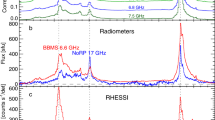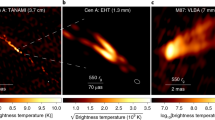Abstract
IT has been suggested by Strom and Strom1 that the sporadic decameter radio energy attributed to the planet Jupiter does not actually originate on that body, but comes rather from a distant background of discrete sources or ‘radio stars’. According to the Stroms, the Jovian ionosphere could act as a gigantic spherical lens to focus energy on the Earth when these discrete sources are temporarily occulted by Jupiter. This theory is rendered more plausible by the work of Grossi, Strom and Strom2, which shows that the ionosphere of the Earth itself may behave as such a lens in the frequency region of 5–30 Mc/s. The well-established correlation of the Jovian outbursts with the rotation of that planet is explained as a result of a magnetic field, tilted with respect to Jupiter's axis of rotation, which is presumed to introduce a periodic modulation in the focusing mechanism.
Similar content being viewed by others
References
Strom, S. E., and Strom, K. M., Astrophys. J., 136, 307 (1962).
Grossi, M. D., Strom, K. M., and Strom, S. E., Smithsonian Astrophys. Obs. Spec. Rep., No. 76 (1961).
Douglas, J. M., Ph.D. dissertation, Yale University (1960).
Brown, G. W., M.S. thesis, University of Florida (1963).
Shklovsky, I. S., Cosmic Radio Waves, 133 (Harvard Univ. Press, Cambridge, Mass., 1960).
Author information
Authors and Affiliations
Rights and permissions
About this article
Cite this article
SMITH, A., SIX, N., CARR, T. et al. Occultation Theory of Jovian Radio Outbursts. Nature 199, 267–268 (1963). https://doi.org/10.1038/199267a0
Issue Date:
DOI: https://doi.org/10.1038/199267a0
- Springer Nature Limited





